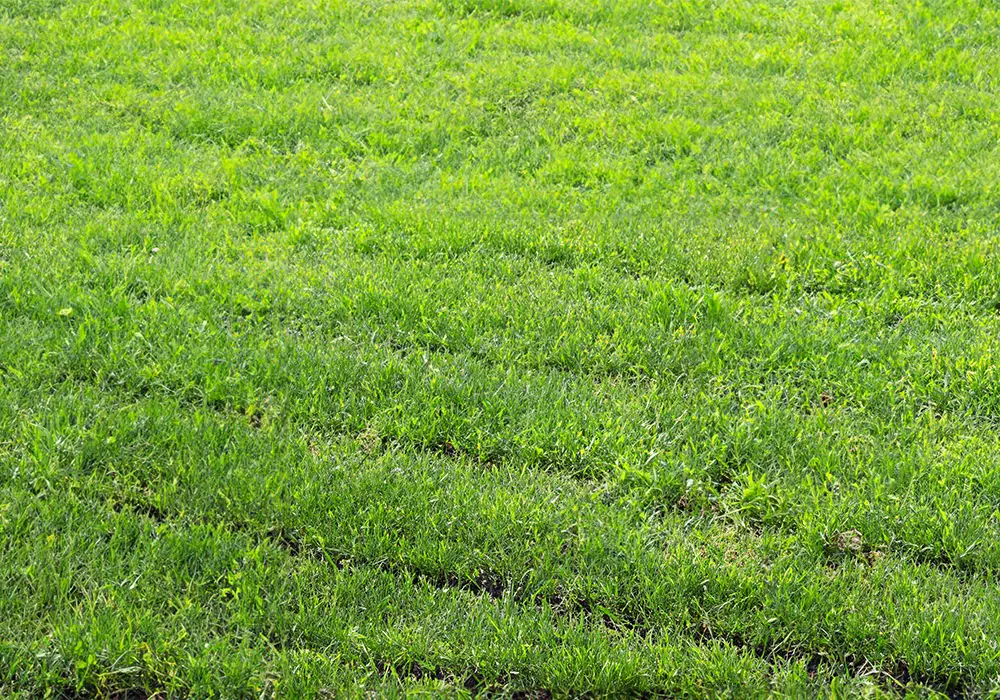
The growing use of robot mowers in lawn care is an established trend. Despite this, there are still rumours going around, claiming that robots contribute to the formation of thatch on a lawn. It isn’t true. If thatch appears, it’s important to review your fertilising method. The mulching performed by your robot already plays an essential part in maintaining healthy, green grass free from Thatch.
Thatch on the lawn: what causes it?
Thatching on the lawn can cause considerable damage to the grass and can affect its growth. This layer of organic material that forms on the surface of the ground consists of plant debris, dead roots, and other organic matter that accumulates over time. There are, therefore, several factors that can cause Thatch.
- Inadequate fertilisation: If the grass does not receive enough nutrients, it might struggle to develop properly. This promotes a build-up of organic matter. The creation of Thatch has traditionally been attributed to the incorrect use of fertilisers, and particularly the excessive application of nitrogen (N), phosphorus (P), and potassium (K).
- Insufficient mowing: When the grass is too long, mulching does not produce the efficient results. Instead, it causes the accumulation of plant debris on the ground.
- Overwatering: If the ground is constantly damp, the micro-organisms that help to decompose organic materials cannot operate efficiently.
How can you prevent thatch on the lawn?
The presence of Thatch on a lawn is a common problem. Don’t worry! It can be prevented.
- We recommend that you mow the grass regularly to keep it at a constant length.
- Aerating the soil is an essential action to prevent Thatch. Soil compaction can prevent the penetration of water and air.
- Another factor to consider is appropriate watering of the lawn. It is important to water according to your lawn’s needs, by watering deeply but less often. This will encourage deep, strong roots. Avoid light watering, which simply promotes the development of Thatch and shallow roots.
There’s no denying that Thatch is a real scourge. But did you know that robot mowers make an essential contribution to fertilising the ground?
Mulching: a green technique for a healthy lawn
With robot mowers, the fertilisation method can be adapted to prevent the development of Thatch. Robot mowers equipped with the mulching function are highly recommended.
Mulching is a mowing technique that involves chopping the cut grass finely and leaving in on the lawn. This method has several advantages:
- Considerable reduction in mowing waste. Instead of collecting the cut grass and throwing it away, mulching leaves it on the lawn. It decomposes rapidly and nourishes the soil.
- Improved soil quality, with essential nutrients for grass. Grass cuttings are rich in nitrogen, phosphorus and potassium: the important nutrients for lawn growth. By leaving the grass cuttings on the lawn, robot mowers return those nutrients to the soil. From there, the grass roots will absorb them. Result: Healthier grass that is more resistant to disease and parasites.
- Less Thatch on the lawn. As mentioned earlier, Thatch on a lawn is a layer of organic material that forms on the surface of the soil. It can damage the grass. By leaving the grass cuttings on the lawn, robot mowers help to promote the decomposition of the organic matter and to eliminate it from the grass.
Fertilisation by robot mowers: a key ingredient for a healthy, green lawn
Fertilisation plays an essential part in maintaining a healthy, green lawn. The main purpose to ensure luxuriant grass in perfect health is to provide the three essential nutrients for grass growth: nitrogen (N), phosphorus (P), and potassium (K).
The choice of fertiliser is crucial in order to guarantee efficient and sustainable fertilisation of the ground. This choice will depend, in part, on the specific needs of each property. You should consider the soil composition and the climate when making your choice of fertiliser.
Although fertiliser is essential, its excessive use can cause a build-up of salts in the soil, which is detrimental to the growth of the grass. With the mulching technique, there will be no further need to fertilise your grass. You will have to adjust your fertilising routine to avoid a nitrogen surplus and the development of Thatch.
In conclusion, the use of a robot mower with the mulching feature produces a major transformation in the approach to fertilising. It not only guarantees well-maintained lawns; it is also a big factor in reducing the development of Thatch.
Robot mowers provide natural, balanced fertilisation, with uniform distribution of nutrients all over the lawn. So don’t hesitate to let these robots do the work for you, and enjoy a healthy, luxuriant lawn all year round. Do you want to find out more about the mulching capabilities of our robot mowers or test Belrobotics equipment? Do not hesitate to contact our experts.




